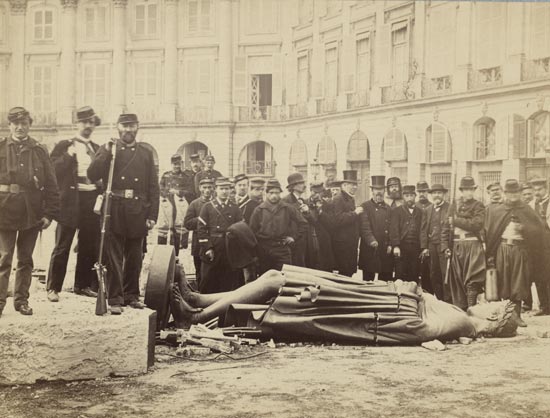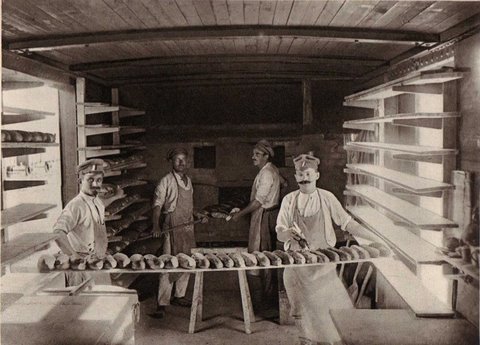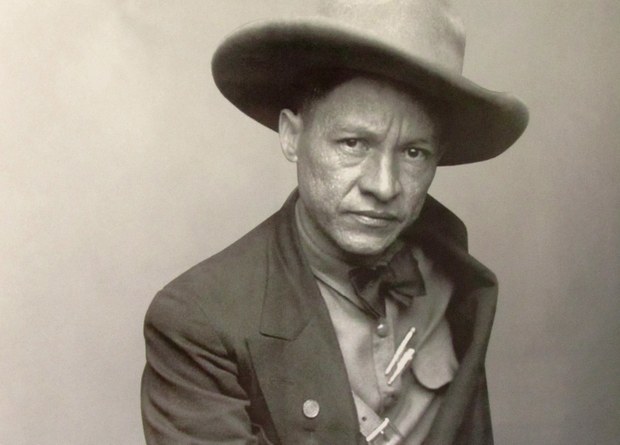Chapter 133 - The Culture Pope and the Artistry of Dissent - Inside the Union of Europe
Chapter One Hundred and Thirty Three: The Culture Pope and the Artistry of Dissent - Inside the Union of Europe
"Beloved imagination, what I most like in you is your unsparing quality"
First line of the Unconscious Manifesto, 1926.

The pulling down of the Vendomme Column, the monument to victory at Austerlitz, was a key moment in 1871, as symbolic as storming the Bastille in 1789
When the Unconscious Manifesto appeared on the Parisian Art Scene in the season of 1926 it proved one of the most troubling, chaotic, divisive moments in Art History. The brainchild of two men, Andre Breton and Alfred Jarry, and one woman, Sonia Stern, it was an ardent rejection of an art-scene that had become increasingly derided as sterile and politically-subservient.
Art had been at the very heart of the Paris Commune since 1871. Gustave Courbet was one of the leading lights of realism, whose paintings of poor peasants and simple subjects in unflinching verisimilitude had earned him the ire of the established art world and made him the doyen of the counter-culture of the Second Empire. In 1871 he had brought together a group of some four hundred artists in Paris, during the height of the Commune, to set out an artistic vision of the socialist future at hand. No more salons, prizes, commissions, or codified and restricted "schools". Art was, like the masses, to be liberated in the new dawn of civilization.
And, in the 1880s and 1890s, it seemed that Courbet and his group would be proved right. A flourishing of artistic endeavor, from Impressionism to Communism [a less well-known group painting style], swept throughout France. The Communal Government remained remarkably open to the idea of allowing the arts to flourish, with first Courbet and then a series of important artists given free-hand in distributing the often ample funds provided by the central government and local communes. Yet the death of the patronage system, as many rich families fled first France and then the expanding socialist territories of Europe, meant that the government stipends were often the only secure source of income for aspiring artists. This led to charges the the Government was directing art through the funds, channeling support to those works that glorified the regime or spoke to the social realist style that ardent socialists favoured most.

Siege of Marseilles, 1903 by Eduard Lavalles - one of the works of art criticized by Alfred Kerr as sterile and politically subservient.
This stood in stark contrast to the art scene outside of the Union. In truth the new Exodism sweeping through the non-socialist art world was as much a product of refugees from Russia as from those leaving the Union of Europe, but from 1919 onwards the all-embracing forms of Exodism found particular expression in Berlin, in Prague, and in Edinburgh. An attempt to embrace the modernity of the new century whilst still echoing traditional and conservative national themes, Exodism embraced everything from furniture to sculpture, painting to interior design. Notable instances, for example, were Charles Rennie Mackintosh's medieval-inspired furniture and Gustave Klimt's richly gold-encrusted 'Byzantine Series' of murals in Bratislava. A rich and inspiring vein, it left many art critics derisive of the 'sterility' of socialist art. The influential Alfred Kerr, known as the 'Culture Pope', announced in 1926 that 'Art in Paris is Dead'.
It was this that stirred the Unconscious Circle to life. The publication of their manifesto, to great fanfare at a grand display in the 17th Arrondissement,divided public opinion. Most shocking of all was the manifesto's cover. It was a photomontage of the Vendomme column, toppled by Courbet during the Commune uprising of 1871 - a moment heavily invested in the memory of 1871 as a symbol of the new revolution's rejection of monarchy and tradition. But in the Unconscious image the column was erect again, the statue of Napoleon I replaced by a pompous looking Courbet, whilst the Unconscious artists had placed themselves around the base holding ropes and hooks.

Prisms Electrique, 1925, by Sonia Stern. One of the new Unconscious works that sought to challenge conventions of form and style in European art.
'The collapse of the Vendomme Column was the first AND LAST act of radicalism in the history of the Commune' the group manifesto declared, causing a deep and bitter political argument across society. It was a worrying indicator of the growing discontent that was affecting the people of the Union.
"Beloved imagination, what I most like in you is your unsparing quality"
First line of the Unconscious Manifesto, 1926.
The pulling down of the Vendomme Column, the monument to victory at Austerlitz, was a key moment in 1871, as symbolic as storming the Bastille in 1789
When the Unconscious Manifesto appeared on the Parisian Art Scene in the season of 1926 it proved one of the most troubling, chaotic, divisive moments in Art History. The brainchild of two men, Andre Breton and Alfred Jarry, and one woman, Sonia Stern, it was an ardent rejection of an art-scene that had become increasingly derided as sterile and politically-subservient.
Art had been at the very heart of the Paris Commune since 1871. Gustave Courbet was one of the leading lights of realism, whose paintings of poor peasants and simple subjects in unflinching verisimilitude had earned him the ire of the established art world and made him the doyen of the counter-culture of the Second Empire. In 1871 he had brought together a group of some four hundred artists in Paris, during the height of the Commune, to set out an artistic vision of the socialist future at hand. No more salons, prizes, commissions, or codified and restricted "schools". Art was, like the masses, to be liberated in the new dawn of civilization.
And, in the 1880s and 1890s, it seemed that Courbet and his group would be proved right. A flourishing of artistic endeavor, from Impressionism to Communism [a less well-known group painting style], swept throughout France. The Communal Government remained remarkably open to the idea of allowing the arts to flourish, with first Courbet and then a series of important artists given free-hand in distributing the often ample funds provided by the central government and local communes. Yet the death of the patronage system, as many rich families fled first France and then the expanding socialist territories of Europe, meant that the government stipends were often the only secure source of income for aspiring artists. This led to charges the the Government was directing art through the funds, channeling support to those works that glorified the regime or spoke to the social realist style that ardent socialists favoured most.

Siege of Marseilles, 1903 by Eduard Lavalles - one of the works of art criticized by Alfred Kerr as sterile and politically subservient.
This stood in stark contrast to the art scene outside of the Union. In truth the new Exodism sweeping through the non-socialist art world was as much a product of refugees from Russia as from those leaving the Union of Europe, but from 1919 onwards the all-embracing forms of Exodism found particular expression in Berlin, in Prague, and in Edinburgh. An attempt to embrace the modernity of the new century whilst still echoing traditional and conservative national themes, Exodism embraced everything from furniture to sculpture, painting to interior design. Notable instances, for example, were Charles Rennie Mackintosh's medieval-inspired furniture and Gustave Klimt's richly gold-encrusted 'Byzantine Series' of murals in Bratislava. A rich and inspiring vein, it left many art critics derisive of the 'sterility' of socialist art. The influential Alfred Kerr, known as the 'Culture Pope', announced in 1926 that 'Art in Paris is Dead'.
It was this that stirred the Unconscious Circle to life. The publication of their manifesto, to great fanfare at a grand display in the 17th Arrondissement,divided public opinion. Most shocking of all was the manifesto's cover. It was a photomontage of the Vendomme column, toppled by Courbet during the Commune uprising of 1871 - a moment heavily invested in the memory of 1871 as a symbol of the new revolution's rejection of monarchy and tradition. But in the Unconscious image the column was erect again, the statue of Napoleon I replaced by a pompous looking Courbet, whilst the Unconscious artists had placed themselves around the base holding ropes and hooks.

Prisms Electrique, 1925, by Sonia Stern. One of the new Unconscious works that sought to challenge conventions of form and style in European art.
'The collapse of the Vendomme Column was the first AND LAST act of radicalism in the history of the Commune' the group manifesto declared, causing a deep and bitter political argument across society. It was a worrying indicator of the growing discontent that was affecting the people of the Union.













